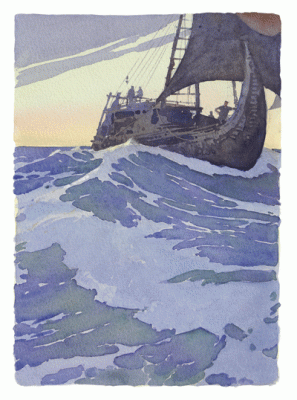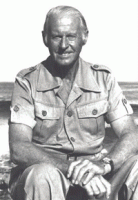Thor Heyerdahl set out to sail the Atlantic in a papyrus boat, its design copied straight from the pyramids of the pharaohs.
Sun and moon rolled westward in turn to show us the way. The lonely night watches gave us in full measure that timeless perception of eternity that I had experienced on Kon-Tiki. Stars and night-black water. The immutable constellations sparkled above us, and just as brightly beneath us the shining phosphorescence glittered: the living plankton glowed like sparks of neon on the soft dark carpet on which we were floating. We often seemed to be riding under the night sky on a billowing mirror, or perhaps the sea was crystal- clear and bottomless, so that we could see right through it to myriads of stars on the other side of the universe. The only thing that was firm and near in these omnipresent stellar heavens was the supple bundle of golden reeds on which we rode, and the big, square sail which stood like a shadow against the stars, broader above, by the yard arms, than across the bottom, near the deck.
This ancient Egyptian outline of the trapeze-shaped sail was enough in itself to turn the calendar back thousands of years. Silhouettes of sails like these are not seen against the sky today. Strange squeaks and snorts from papyrus, bamboo, wood and rope did the rest. We were not living in the age of the atom bomb and the rocket. We were living at a time when the earth was large and flat and full of unknown seas and continents, when time was the common prerogative and no one was short of it.
Stiff, but fitter from the struggle which now lay behind us, we changed watches by the meagre light of paraffin lamps swaying above our undulating vegetable deck. It was unspeakably good to crawl to rest in a warm sleeping bag. You woke up with such an infernally good appetite. You felt an extraordinary physical wellbeing. Small pleasures grew big; big problems felt small. The Stone Age life was certainly not to be despised. There was no reason to believe that people who lived before us, and had to make vigorous use of their bodies, merely had a hard time and did not receive their due share of life’s joys.
Westward progress of over one hundred kilometres (or nearly sixty nautical miles) could be plotted on the chart every day, even though the horizon never changed. The border line between sea and sky was the same every day and at all times of day. The horizon moved with us and we were always its focal point. But the masses of water also moved invisibly with us. The Canary current was a fast-moving, salt- water river flowing towards the setting sun, keeping eternal company with the trade wind, westward, westward, air and water and all that floats and blows. Westward with sun and moon.
We gradually began to learn interesting lessons from our testing of the papyrus boat. The slanted rudder-oars had been the first to disclose their secrets, showing themselves to be a missing link in the evolution of man’s earliest steering mechanism from oar to rudder. Next the wash-through bundle-body of the raft ship itself began to reveal its true qualities. In addition to an almost unbelievable loading capacity the papyrus reeds possessed both a toughness in rough seas and an enduring buoyancy which quite contradicted the preconceived verdict of modern man. Yet it was the rigging that revealed the most significant secrets about this ancient vessel’s forgotten history, showing that it had been originally developed as something more than a mere river craft. In the design we followed, Landstrom had copied all the details of a mast and rigging from the ancient Egyptian wall paintings. A strong rope ran from the masthead to the bow of the boat. But no corresponding rope ran from masthead to stern, although one rope forward and one aft would have been the logical requirement to hold the straddled mast erect on a river boat in calm waters.
The ancient Egyptian ships’ architects, however, carefully and strikingly avoided any rope running from the masthead all the way aft. Instead they secured five or six ropes at different heights on each of the two straddled masts and these ropes were stretched diagonally down in parallel lines to either side of the vessel a little aft of midships. In this way the whole sternmost part of the boat was free of mast stays and could rise and fall on the waves with no attachment to the mast. No sooner had Ra begun to pitch on the high seas than we realised how extraordinarily important this special system was. The stern hung behind the rest of the boat like a trailer which must be allowed to ride up and down freely over all the bumps. Had it also been secured by a stay to the masthead, the mast would have broken as the first big ocean rollers surged beneath us. In our dance over the high wave-crests the middle section of Ra was rhythmically thrust upwards while the full weight of bow and stern sagged simultaneously in the wave-troughs on either side. Had both ends of the hull been attached to the mast, it would have broken under the pressure. As things were, the mast was well able to support the curved prow while holding the central part of the soft deck suspended in a straight line. Everything which lay farther aft was allowed to follow the motion of the sea.
Norman the naval expert, in particular, saw at once what it meant. The creators of the old Egyptian rigging had prepared their flexible reed boats for the meeting with ocean swells. After the third day at sea I was already writing in my diary: ‘This rigging is the result of a long experience in navigation on the open sea; it was not born on the calm Nile.’
Thor Heyerdahl
Born in Norway in 1914, Heyerdahl became famous for his daring Kon-Tiki expedition in 1947, sailing a balsa-wood raft 5,000 miles (8,000km) across the Pacific Ocean from South America to the Tuamotu Islands. As an ethnographer, Heyerdahl’s voyage proved possible
his theory that the Pacific islands were populated from the west and not the east as
previously thought, and that ancient and cultures could have made contact across vast distances. The book The Kon-Tiki Expedition: By Raft Across the South Seas has been translated into over 70 languages and recently made into a feature film.
The Ra expeditions set out to prove similar theories, this time of links between the Egyptian and the South American cultures, which shared similar architecture,
religion and boat-building skills. The only missing link was how they crossed the Atlantic in a papyrus boat. The first Ra sailed in 1969 and made it to within a hundred miles of the Caribbean islands before sinking, the crew rescued by a yacht. The following year, with a refined design, Ra II, the crossing from Morocco to Barbados took 57 days. Heyerdahl married three times and died in 2002, aged 87.
The Ra Expeditions was first published in 1970 in Norwegian and in English by George Allen & Unwin in 1971. Various editions have followed. It is available online from around £5.
If you’d like to see an excerpt from your favourite sailing book in Yachting Monthly, please write to theo.stocker@ timeinc.com






